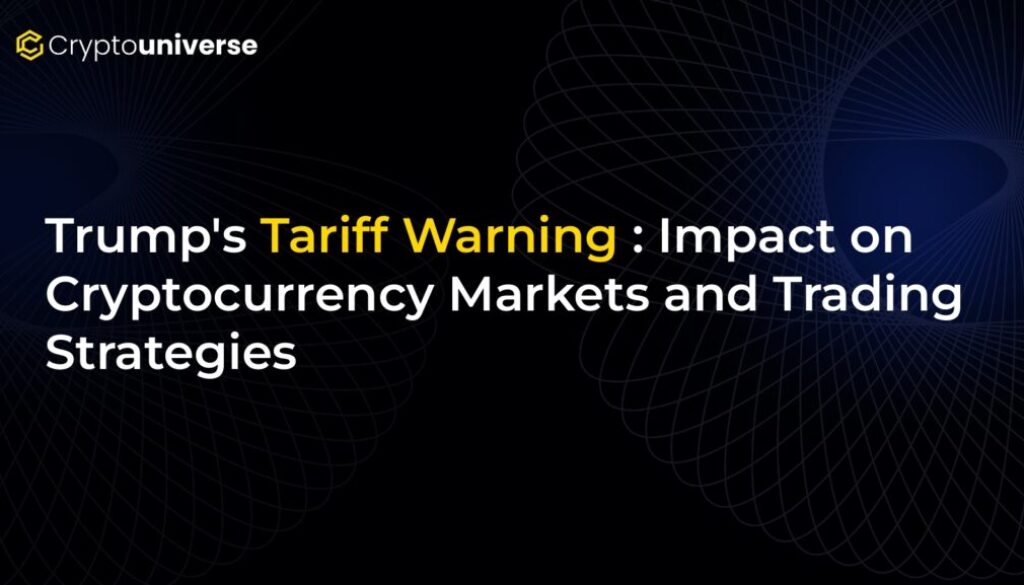Trump’s Tariff Warning: Impact on Cryptocurrency Markets and Trading Strategies

Trump’s Tariff Talk Shakes Crypto Markets
Recent pronouncements regarding potential trade tariffs under a possible future Trump administration have sent ripples across global financial markets, and the cryptocurrency space is no exception. As reported by financial blogs like WallStreetBulls, the prospect of renewed trade tensions, particularly concerning electronics and imports from key partners like China, Mexico, and Canada, is injecting significant uncertainty and volatility into the digital asset landscape.
Traders and investors are closely watching these developments, as protectionist trade policies can have far-reaching consequences, impacting everything from inflation and economic growth to specific industry sectors.
Immediate Market Reactions: Volatility Spikes
The mere discussion of new tariffs has already triggered noticeable reactions in the crypto market. We’ve seen:
- Significant Price Swings: Bitcoin (BTC) experienced sharp movements, with reports showing dips below key psychological levels like $80,000 after briefly surging higher.
- Altcoin Plunge: Major altcoins like Ethereum (ETH), Solana (SOL), Cardano (ADA), and even meme coins like Dogecoin (DOGE) saw considerable percentage drops following tariff-related news.
- Mass Liquidations: The sudden volatility led to substantial liquidations in the derivatives market, sometimes amounting to hundreds of millions of dollars within hours, indicating highly leveraged positions being wiped out.
- Conflicting Sentiment: Social media platforms like X (formerly Twitter) buzzed with contrasting opinions. Some view the tariff news as a bearish signal, potentially harming both stocks and crypto, while others see the dips as potential buying opportunities.
Why Do Tariffs Impact Cryptocurrency?
The connection between trade tariffs and crypto prices might not seem direct, but several factors are at play:
- Risk-Off Sentiment: Major geopolitical or economic uncertainty, like that caused by trade wars, often leads investors to shed riskier assets. Cryptocurrencies, particularly Bitcoin, have increasingly shown correlation with traditional risk assets like tech stocks. When broader markets tumble due to tariff fears, crypto often follows suit.
- Impact on Tech Sector: Tariffs specifically targeting electronics, semiconductors, and the tech supply chain could indirectly affect blockchain projects and companies reliant on this hardware. This adds a layer of fundamental concern for certain parts of the crypto ecosystem.
- Inflation and Economic Growth Concerns: As noted by analysts like Agne Linge (@agnecrypto), tariffs can fuel inflation and potentially lead to economic contraction. While some argue crypto could act as an inflation hedge long-term, the immediate reaction to policies that might slow economic growth tends to be negative for speculative investments.
- Potential Long-Term Case?: Conversely, some argue that ongoing trade disputes and geopolitical fragmentation could strengthen the case for decentralized, borderless digital assets like Bitcoin in the long run. However, this remains a theoretical argument often overshadowed by short-term market reactions.
Which Crypto Sectors Are Most Vulnerable?
Research, including analysis from the Binance Research team, suggests not all crypto assets react equally:
- Most Affected: Meme coins and AI-related tokens, often considered the most speculative corners of the market, have reportedly seen the steepest declines during tariff-induced volatility.
- Least Affected: Real-World Asset (RWA) tokens and potentially CEX (Centralized Exchange) tokens appear to be less vulnerable, possibly due to their stronger ties to tangible assets or established platforms, making them seem less speculative during uncertain times.
Trading Strategies Amidst Tariff Uncertainty
Navigating the crypto markets during periods of tariff-related volatility requires caution and adaptability. Consider these strategies:
- Stay Informed: Closely monitor news related to trade policies and tariffs, as well as market reactions across both traditional and crypto markets.
- Manage Risk: Given the potential for sudden dips, review your risk management protocols. This includes setting appropriate stop-losses, managing leverage carefully, and potentially reducing position sizes.
- Consider Diversification: Spreading investments across different types of crypto assets (e.g., established Layer 1s, RWAs, potentially reducing exposure to highly speculative tokens) might mitigate sector-specific risks.
- Evaluate “Buy the Dip” Opportunities Carefully: While some traders see dips as buying chances, assess the underlying reasons for the drop and the potential for further downside before committing capital.
- Focus on Fundamentals: Look beyond short-term price action. Are the underlying projects you’re invested in still sound? Does the long-term value proposition remain intact despite macroeconomic headwinds?
Conclusion: Prepare for Continued Volatility
Trump’s tariff warnings serve as a stark reminder of how interconnected global markets are and how macroeconomic policies can significantly impact the cryptocurrency space. While the long-term effects remain debated, the short-term reality is increased volatility and uncertainty.
For traders and investors, staying informed, managing risk diligently, and adapting strategies to the evolving landscape are crucial. Whether these tariffs ultimately present a threat or an opportunity for crypto will likely depend on their final form, implementation, and the broader economic response.
Disclaimer: This article is for informational purposes only and does not constitute financial advice. Always conduct your own research before making investment decisions.


